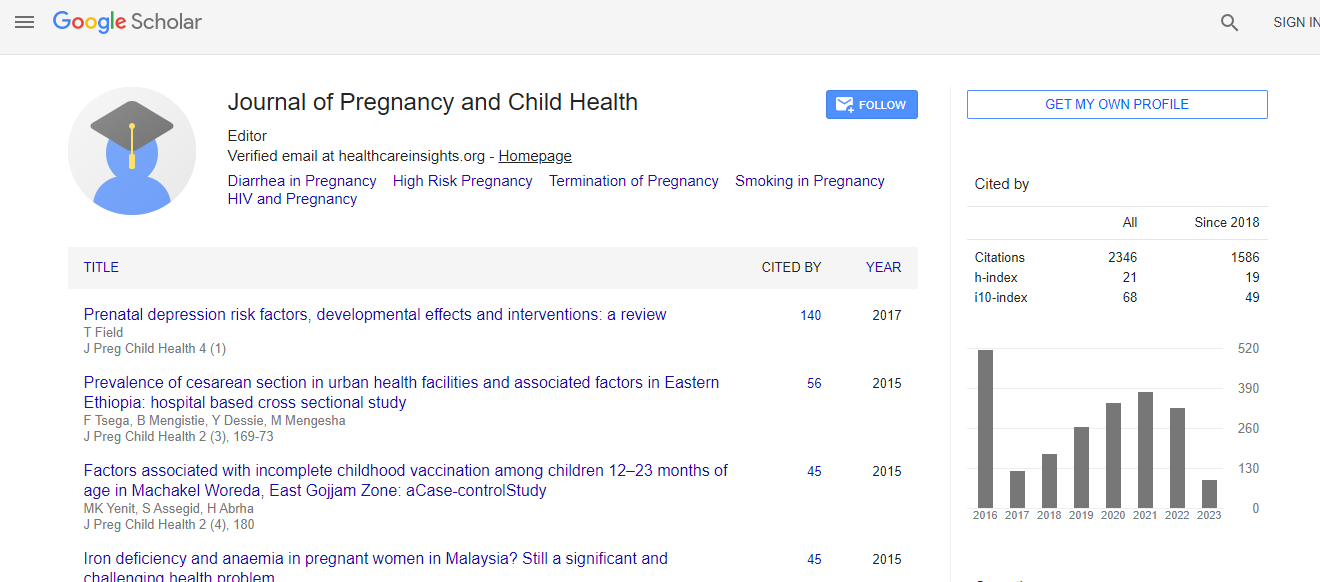Research Article
Correlation between Clinical and Histopathologic Chorioamnionitis in HIV-positive Women
| Hannah Anastasio1*, Meredith Birsner1, Cynthia Argani1, Jean Anderson1, Frederic Askin2 and Zahra Maleki2 | |
| 1Department of Gynaecology and Obstetrics, Johns Hopkins University, Baltimore, Maryland, USA | |
| 2Department of Pathology, Johns Hopkins University, Baltimore, Maryland, USA | |
| Corresponding Author : | Hannah Anastasio Department of Gynaecology and Obstetrics Johns Hopkins University Baltimore, Maryland, USA Tel: 410-955-6710 E-mail: hbrotzm1@jhmi.edu |
| Received: January 13, 2016; Accepted: February 04, 2016; Published: February 11, 2016 | |
| Citation: Anastasio H, Birsner M, Argani C, Anderson J, Askin F, et al. (2016) Correlation between Clinical and Histopathologic Chorioamnionitis in HIV-positive Women. J Preg Child Health 2:217. doi:10.4172/2376-127X.1000217 | |
| Copyright: © 2016 Anastasio H, et al., This is an open-access article distributed under the terms of the Creative Commons Attribution License, which permits unrestricted use, distribution, and reproduction in any medium, provided the original author and source are credited. | |
Abstract
Objective Histopathologic findings of intraamniotic infection include chorioamnionitis and funisitis. Chorioamnionitis is a recognized risk factor for intrapartum HIV transmission. We sought to determine whether histologic placental findings in patients with clinical chorioamnionitis were different between HIV-positive and HIV-negative patients. Study design Retrospective case control study of all cases of clinical chorioamnionitis at The Johns Hopkins Hospital between 1996 and 2010, diagnosed by presence of maternal fever and one or more of the following criteria: maternal or fetal tachycardia, fundal tenderness, malodorous amniotic fluid, or elevated WBC. Placentas of HIV-positive women were matched 1:2 to HIV-negative controls. Placentas were reviewed by two independent pathologists, blinded to HIV status, using 2003 Society for Pediatric Pathology criteria. Primary outcome was histopathologic finding of chorioamnionitis by maternal grade/stage and fetal grade/stage. Results Of 28,915 deliveries, 2,228 met criteria for chorioamnionitis (7.7%), and 11 were HIV-positive (0.5%); one had dichorionic-diamnionic twins with placentas evaluated separately. Parity, gestational age, mode of delivery, Apgar scores, and infant birth weight were similar between groups. WBC at delivery was significantly lower in HIVpositive patients (9 vs. 13 p<0.01), and women with HIV were significantly older (34.4 vs 28.9 years, p=0.05). HIVpositive patients were no more likely to have histologic chorioamnionitis than their HIV-negative controls. Maternal and fetal stage/grade did not vary significantly between groups. Conclusion Among patients with clinical chorioamnionitis, histopathologic confirmation does not differ significantly between HIV-positive and -negative patients. Additionally, histologic chorioamnionitis in the HIV-positive population does not appear to differ in severity from that in the HIV-negative population. White blood cell count at delivery is significantly lower in HIV-positive women with chorioamnionitis compared to HIV-negative controls.

 Spanish
Spanish  Chinese
Chinese  Russian
Russian  German
German  French
French  Japanese
Japanese  Portuguese
Portuguese  Hindi
Hindi 
